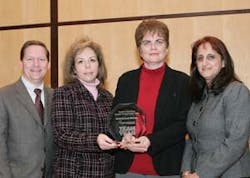On Wednesday, I visited Wyeth’s Pearl River plant to tour the facility and present the Prevnar fill and finish team with its 2007 Team of the Year award. Among those I met were Michael McDermott VP of Site Operations and managing director of Biotech, Alex Tosi, Alex Tosi, senior director, OE and Strategy, Robert Bracco, director, Operations, Fill/Finish PPU, Lynn Bottone, senior director of the site’s fill and finish operations, who moved to that position from QA, and Sonya Kakkar, director of QA, who came from that position from the Microbiology department.
The facility will start manufacturing a new form of the vaccine, a 13 rather than 7 serotype, and has converted from vial filling to prefilled syringes, a move that eliminated manual work and simplified operations and efficiency. However, it will be devoting an entire line to produce Prevnar 7 for export to the developing world, in projects coordinated by Unicef, WHO and other international organizations.
The site was remarkable for the level of automation, the centerpiece of which is an Eisai vision inspection system as well as robotics and filling technology from Uhlman and Inova.
However, it will also implement Rockwell MES technology at the fill and finish facility in January.
I’ll be writing a series of short articles on various aspects of what is going on at Pearl River, but below are some quick sound bites and the substance of a quick interview with Michael McDermott.
Manufacturing Cycle Time (2005-2007) – Reduced from 125 days to 23 days
Quality Cycle Time (2006-2007) – Reduced by 60 to 90%
Supervisor Time on the Floor (2003-2005) – 46% to 78%
PhM – What are your top corporate and facility goals this year?
MM – We’ve already cut Prevnar cycle time in half since last year across all PPUs in all facilities. These improvements get harder each time, but the team is engaged.
This work requires robust process, good people and good equipment. You cannot drive cycle time first. This initiative has been more about getting our product to patients than reducing cycle times. I’m very excited about the impending submission of Prevnar 13, which will address more types of pneumococcal infections.
13 valent will make the product even truly global and better address emerging incidents of infection.
PM – What are you doing outside of the U.S. and Europe?
MM – Next year, we will begin supplying Prevnar to developing world countries. We are working with WHO, Unicef, to begin to supply product to those who need it most and cannot afford it. We have a brand new line that will be dedicated to vial filling for this purpose.
For the Pearl River facility, operational excellence and continuous improvement is still a key driver only now we’re seeing it blossom in nontraditional areas such as maintenance and even R&D. At a recent OE seminar, one third of the attendees came from R&D.
They’re applying the concepts now in the labs, including 6-S. One recent success story was in pipette calibration. Everyone used to have his or her favorite pipette, we had hundreds of different pipettes and vendors charged premium to calibrate them all. We calculated the costs, then standardized and improved compliance, all while reducing $1.5 million in calibration costs for pipettes….
PhM – What impact do you expect the incoming CEO to have on the site and general operations?
MM – Bernard Poussot was groomed for this position for many years and brings an amazing business and quality sense. He has rooted mission, vision and values and has had strong drive in terms of research. We’re excited about the transition
PhM - What changes in the Wyeth pipeline will have an impact on Pearl River operations?
MM – On the consumer side, we relaunched entire Centrum family and rebranded enhanced formulations such Centrum Cardio multivitamin with phyto sterols for lowering cholesterols. We will continue other opportunities in supplement sides.
On the pharma side, we’re developing therapies in three different delivery types, including a vaccine, for Alzheimers. Our oncology line is also growing.
PhM – What are you doing in terms of implementing Quality by Design, at Pearl River?
MM - FDA and global reg agencies continue to talk about the importance of QbD and PAT, and we couldn’t agree more. We’ve piloted that concept in a number of new product launches, and critical to get it in place early in.
In the packaging line we’ve impelemented vision sensing and sensors. Upsteam, we’re implementing PAT and QbD and have some great examples to talk about. Both these initiatives are very important because they force one to focus on what’s critical. In this industry, we can get buried in procedures and measure everything. There is a real need to understand critical process parameters….
PhM – Are you moving into electronic batch recordkeeping?
MM - The industry and Agencies still like their big stacks of paper, but we view the move to EBR as an important evolution. Tied into that will be our new Prevnar MES implementation at Pearl River. We will be the first of Wyeth’s biotech sites to integrate MES fully.
PhM – What is Wyeth doing to revamp its supply chain management systems?
MM – On the consumer side, we’ve implemented SCM for Centrum, where we’re using more of a Pull approach. Getting a global platform in place, putting APO on top of that to be able to do planning. APO is currently running on Prevnar today. If you go into our SCM project director Ed De Beau’s office with a spreadsheet, you get kicked out.
On the consumer side, we’re taking signals from distribution and we’re now taking signals directly from distribution centers, e.g. WalMart,






